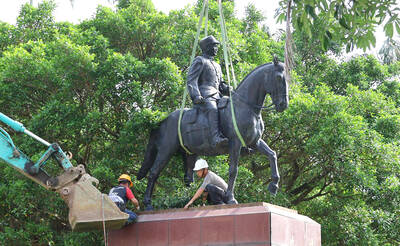Nothing bridges nature and culture more than pottery. That's the idea that the Yingge Ceramics Museum was built on and its permanent exhibits alone make a compelling case for it. Clay was the first thing humans built with and it remains the foundation of the civilized world; from dinner plates to dentures and from engine cylinders to silicon chips.
Now the past two centuries of Taiwan's ceramics history can be seen at the museum in a special exhibition -- 200 Years in Yingge starts today and runs through Saturday, Oct. 30.

PHOTO: DAVID MOMPHARD, TAIPEI TIMES
The cause for the celebration is the arrival in Yingge 200 years ago of Wu An (吳鞍), the first potter from Guangzhou to settle in the area and take up his trade. He was later joined by a brick maker named Chen Kun (陳昆) and the two helped make the area into the center of Taiwan's ceramics industry. Today, Yingge is known as much for the commodes and cable insulators it supplies to the world as for the works of art its craftsmen create.
While a bicentennial is cause to celebrate, there's reason enough to travel to the Taipei County township without it. The Yingge Ceramics Museum is world-class -- not a term usually associated with Taiwan's countless museums -- and the town it sits in has quite literally formed a unique identity for itself over the centuries.
Beginning at the museum, you can learn about the start of Taiwan's ceramics industry, when sampans on the Dahan River floated cups and bowls downstream, and about the prosperous days that came with the railroad. Then you can exit the museum and sift through stacks of plates seven decades deep. You'll be surprised at what you find (locally manufactured Japanese-era rice bowls, for example) and surprised at the cost (NT$100 per piece).
Yingge's history has been captured not only in clay, but through the camera, as well, and the 200-year exhibit's must-see section is Memories of Trains, housed in the town's old train station, next door to the new train station.
Taking the idea that clay bridges nature and civilization a step further, the museum will offer several special activities over the next two weeks as a part of the 200-year anniversary exhibit. A one-day environmental tour of the township will take visitors on a tour of the local incinerator and to a DIY recycling shop. There are also tours of the hundreds of both modern and traditional kilns in the area. Both tours are available weekends only.
The Yingge Ceramics Museum is located at 200 Wenhua Rd, Yinge Township, Taipei County (北縣鶯歌鎮文化路200號). To get there, take the train to the Yingge Railway Station and follow the big green and white signs to the museum and special exhibit centers. The exhibits are open until 5pm on weekdays and until 6pm on weekends. Admission is NT$200. More information about the exhibitions can be viewed on the Web at www.ceramics.tpc.gov.tw.

May 6 to May 12 Those who follow the Chinese-language news may have noticed the usage of the term zhuge (豬哥, literally ‘pig brother,’ a male pig raised for breeding purposes) in reports concerning the ongoing #Metoo scandal in the entertainment industry. The term’s modern connotations can range from womanizer or lecher to sexual predator, but it once referred to an important rural trade. Until the 1970s, it was a common sight to see a breeder herding a single “zhuge” down a rustic path with a bamboo whip, often traveling large distances over rugged terrain to service local families. Not only

Moritz Mieg, 22, lay face down in the rubble, the ground shaking violently beneath him. Boulders crashed down around him, some stones hitting his back. “I just hoped that it would be one big hit and over, because I did not want to be hit nearly to death and then have to slowly die,” the student from Germany tells Taipei Times. MORNING WALK Early on April 3, Mieg set out on a scenic hike through Taroko Gorge in Hualien County (花蓮). It was a fine day for it. Little did he know that the complex intersection of tectonic plates Taiwan sits

The last time Mrs Hsieh came to Cihu Park in Taoyuan was almost 50 years ago, on a school trip to the grave of Taiwan’s recently deceased dictator. Busloads of children were brought in to pay their respects to Chiang Kai-shek (蔣中正), known as Generalissimo, who had died at 87, after decades ruling Taiwan under brutal martial law. “There were a lot of buses, and there was a long queue,” Hsieh recalled. “It was a school rule. We had to bow, and then we went home.” Chiang’s body is still there, under guard in a mausoleum at the end of a path

Last week the Directorate-General of Budget, Accounting and Statistics (DGBAS) released a set of very strange numbers on Taiwan’s wealth distribution. Duly quoted in the Taipei Times, the report said that “The Gini coefficient for Taiwanese households… was 0.606 at the end of 2021, lower than Australia’s 0.611, the UK’s 0.620, Japan’s 0.678, France’s 0.676 and Germany’s 0.727, the agency said in a report.” The Gini coefficient is a measure of relative inequality, usually of wealth or income, though it can be used to evaluate other forms of inequality. However, for most nations it is a number from .25 to .50